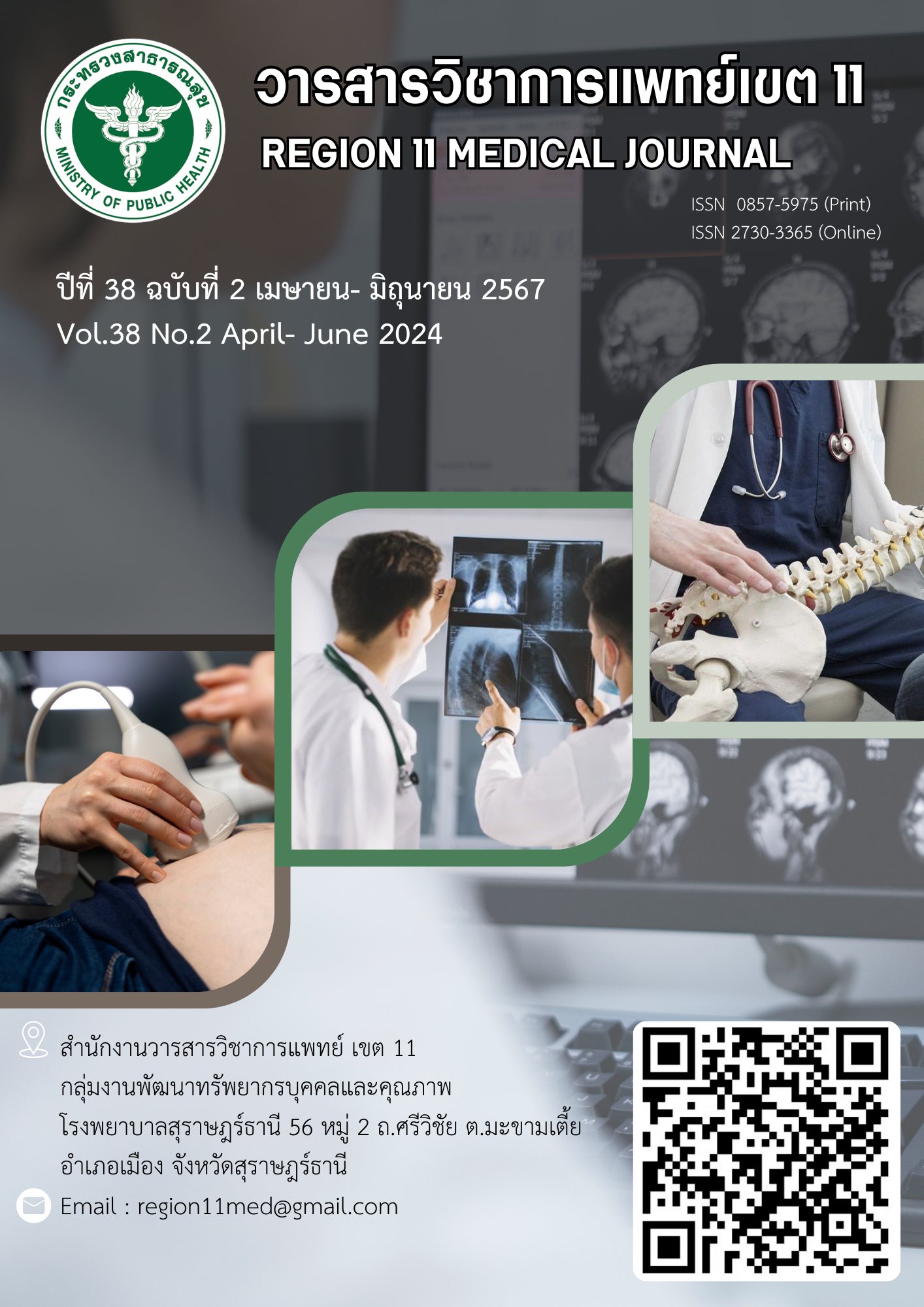Impact of mindfulness program on stress and blood pressure in Members with risk hypertension, Mueang district health service network Surat Thani
Keywords:
Mindfulness program, stress, Groups at risk for high blood pressureAbstract
Background: High blood pressure is a major health problem for people around the world, and it is the cause of premature death. Mindfulness stimulates the functioning of the nervous system and blood flow in the brain, stimulates the release of more dopamine, causing the body to relax, heart rate decreased but regularity increased. Therefore, causing the pressure in the blood vessels to decrease into blood pressure therefore decreases.
Objectives: To study the effects of a mindfulness program on stress and blood pressure in groups at risk for high blood pressure
Method: The sample group is people who have been screened as being at risk. There is a blood pressure level >120/80-139/89 mmHg, age 35 years and over, purposive sampling, random sampling into experimental and control groups by drawing lots. Matching the similarity of gender groups, ages, and educational levels, and meditation experience. The sample size was determined with the G*Power program, resulting in a total sample size of 70 people. The tool used in the experiment was the mindfulness program Mindfulness – Base Stress Reduction (MBSR). The content validity of the CVI was 0.87. The data were analyzed and compared using statistics: independent t-test and pair t-test.
Results: Found that stress and blood pressure before receiving the program were not different between the experimental group and the control group. But after receiving the program, it was found that the experimental group's stress and blood pressure were lower than those in the control group with statistically significant.
Conclusion: Mindfulness program can reduce stress and lower blood pressure levels at risk group with statistical significance.
References
นิตยา กระจ่างแก้ว, บุญทิพย์ สิริธรังศรี และวันเพ็ญ ภิญโญภาสกุล. ผลของโปรแกรมการจัดการภาวะความดันโลหิตสูงสำหรับผู้ป่วยโรคหลอดเลือดสมอง. วารสารวิชาการสาธารณสุข. 2565; 31(4):725-734.
ปิยรัตน์ ชลสินธุ์ และจุฬารักษ์ กวีวิวิธชัย. ผลของโปรแกรมควบคุมความดันโลหิต ต่อความเชื่อด้านสุขภาพพฤติกรรมสุขภาพ ปริมาณโซเดียมที่ได้รับและระดับความดันโลหิตของผู้เป็นโรคความดันโลหิตสูงในชุมชน. วารสารสภาการพยาบาล. 2559;31(4):63-75.
พานทิพย์ แสงประเสริฐ. ผลของการฝึกสติต่อพฤติกรรมสุขภาพและคุณภาพชีวิตในผู้ป่วยโรคความดันโลหิตสูง. (ดุษฎีนิพนธ์สาขาวิชาเวชศาสตร์ชุมชนและเวชศาสตร์ครอบครัว) บัณฑิตวิทยาลัยมหาวิทยาลัยธรรมศาสตร์. 2561
สุดฤทัย รัตนโอภาส. ประสิทธิผลของโปรแกรมการดูแลสุขภาพตนเองของผู้ป่วยความดันโลหิตสูงโรงพยาบาลปากน้ำชุมพร. วารสารอายุรศาสตร์ มหาวิทยาลัยขอนแก่น. 2560;3(4):59-66.
World Health Organization. A global brief on hypertension. 2013 Retrieved from http://www.who.int/cardiovascular_diseases/publications/global_brief_hypertension/en/
ศูนย์เทคโนโลยีสารสนเทศและการสื่อสาร สำนักงานปลัดกระทรวงสาธารณสุข. กลุ่มรายงานมาตรฐานการป่วยด้วยโรคไม่ติดต่อที่สำคัญ. 2561 สืบค้นเมื่อ 12 มีนาคม 2565, from https://hdcservice.moph.go.th/ hdc/ main/index_pk.php
ณัฏฐินี เสือโต, แอนน์ จิระพงษ์สุวรรณ, ทัศนีย์ รวิวรกุล และมธุรส ทิพยมงคลกุล. ผลของโปรแกรมส่งเสริมพฤติกรรมการควบคุมความดันโลหิต ในกลุ่มอายุ 35-59 ปี ที่ควบคุมความดันโลหิตสูงไม่ได้. วารสารพยาบาลสาธารณสุข. 2561;32(2):95-115.
สุพัตรา สิทธิวัง, ศิวพร อึ้งวัฒนา และเดชา ทำดี. ผลของโปรแกรมส่งเสริมการจัดการตนเองต่อพฤติกรรมสุขภาพและระดับความดันโลหิตของผู้ที่เป็นโรคความดันโลหิตสูงที่ควบคุมไม่ได้. พยาบาลสาร. 2560;47(2):85-97.
ภณิภารัศมิ์ ธรรมโยธินกุล. ผลของการใช้โปรแกรมส่งเสริมสุขภาพรายบุคคลของผู้สงูอายุโรคความดันโลหิตสูงในชุมชนคลองสาม อำเภอคลองหลวง จังหวัดปทุมธานี. 2560 สืบค้นเมื่อ 12 มีนาคม 2565, จากฐานข้อมูล. https:// oldweb.western.ac.th/index.php/th/research-nursingw/research
วรวุฒิ ชมภูพาน, ฐากูร เกชิต, วรางคณา ชมภูพาน, เสาวลักษณ์ ศรีดาเกษ, จรียา ยมศรีเคน, อัจฉรา ชนะบุญ. ผลของโปรแกรมการปรับวิถีชีวิตต่อความดันโลหิตในผู้สูงอายุเพศหญิงที่มีภาวะความดันโลหิตสูงในระยะเริ่มต้น. วารสารพยาบาลกระทรวงสาธารณสุข. 2021;31(1):44-57.
Wu Y, Ma G, Feng N, Zhang Z, Zhang S, Li X. The Pathogenesis and Influencing Factors of Adult Hypertension Based on Structural Equation Scanning. Scanning. 2022 May 27;2022:2663604. doi: 10.1155/2022/2663604. Retraction in: Scanning. 2023 Jun 21;2023:9823960. doi: 10.1155/2023/9823960. PMID: 35686155; PMCID: PMC9166978.
Kabat-Zinn J. Wherever You Go There You Are: Mindfulness Meditation in Everyday Life. Hyperion, New York. 1994.
Witkiewitz, K., Marlatt, G.A., & Walker, D. Mindfulness-based relapse prevention for alcohol and substance use disorders. Journal of Cognitive Psychotherapy. 2005;19(3):211-228.
Proulx K. Integrating mindfulness-based stress reduction. Holistic Nursing Practice. 2003;17(4):201–208.
แนวทางการรักษาโรคความดันโลหิตสูง ในเวชปฏิบัติทั่วไป พ.ศ. 2562 2019 Thai. Guidelines on The Treatment of Hypertension. สมาคมความดันโลหิตสูงแห่งประเทศไทย. จัดพิมพ์ที่ ทริค ธิงค์. เชียงใหม
Cernes R, Zimlichman R. Role of paced breathing for treatment of hypertension. Curr Hypertens Rep, 2017;19(6):1-9.doi10.1007/s11906-017-0742-1.
Lee CK, Park KH, Baik SK, Jeong SW. Decreased excitability and voltage-gated sodium currents in aortic baroreceptor neurons contribute to the impairment of arterial baroreflex in cirrhotic rats. American journal of physiology Regulatory, integrative and comparative physiology. 2016;310(11):1088-101.doi10.1152/ajpregu.00129.2015.
รัตนาวดี แก้วเส้ง, ทรงพร จันทรพัฒน์, ปรียา แก้วพิมล และวิมลรัตน์ จงเจริญ. ผลของโปรแกรมการพยาบาลเพื่อส่งเสริมการบำบัดตนเองด้วยเรกิต่อความเครียดและความดันโลหิตในสตรีตั้งครรภ์ที่มีภาวะความดันโลหิตสูง. วารสารวิทยบริการ มหาวิทยาลัยสงขลานครินทร์. 2561;29(1): 133-147.
Bruno C, Amaradio M, Pricoco G, Marino E, Bruno F. Lifestyle and hypertension: an evidence-based review. Journal of Hypertension and Management. 2018;4(1):1-10.
Liu N, Yang JJ, Meng R, Pan X-F, Zhang X, He M, et al. Associations of blood pressure categories defined by 2017 ACC/AHA guidelines with mortality in China: pooled results from three prospective cohorts. European journal of preventive cardiology. 2022;27(4):345-54.
Whelton PK, Carey RM, Aronow WS, Casey DE, Collins KJ, Himmelfarb CD, et al. Guideline for the prevention, detection, evaluation, and management of high blood pressure in adults: a report of the American College of Cardiology/American Heart Association Task Force on clinical practice guidelines. Journal of the American College of Cardiology. 2017;(19):127-248.
Downloads
Published
How to Cite
Issue
Section
License
Copyright (c) 2024 Region11Medical Journal

This work is licensed under a Creative Commons Attribution-NonCommercial-NoDerivatives 4.0 International License.






